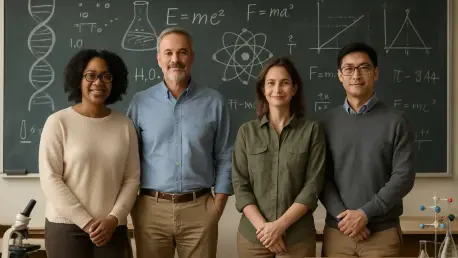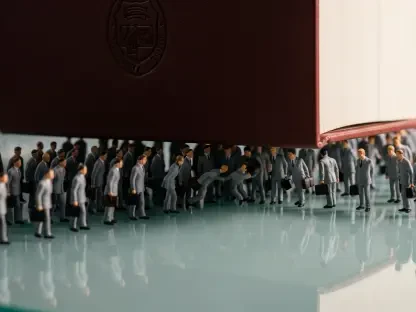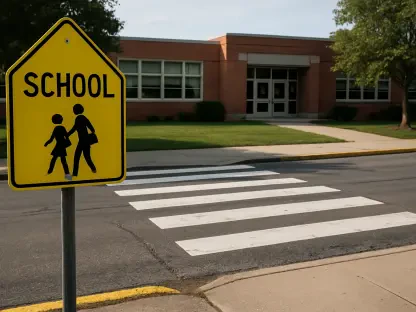In a world increasingly shaped by technological advancements, the urgent need to cultivate a skilled workforce in critical industries like semiconductors and microelectronics has never been clearer, prompting action at all levels of education. A transformative partnership between the University of Rochester in New York and Boise State University in Idaho is stepping up to meet this challenge, fueled by a $2.1 million grant from the National Science Foundation (NSF) and additional backing from the Micron Foundation. This ambitious initiative targets K-12 STEM educators, equipping them to become leaders in these high-stakes fields over the next five years, from 2025 onward. Focused on two states at the heart of a tech surge, the program aims to revolutionize STEM education by inspiring students and aligning curricula with industry demands. It’s a timely effort to bridge the gap between classroom learning and real-world innovation, ensuring that the next generation is ready to tackle the complexities of a tech-driven economy with confidence and expertise.
Shaping the Future Through Educator Leadership
The cornerstone of this initiative lies in recognizing K-12 STEM teachers as pivotal agents of change within regional tech ecosystems. A select group of 15 educators—eight from Idaho and seven from New York—will undergo intensive leadership training at their respective universities. This program is designed to empower them with the skills to craft innovative curricula tailored to semiconductors and microelectronics, while also mentoring fellow teachers through professional development sessions. Their role extends beyond traditional teaching, as they will forge vital connections with industry stakeholders and community organizations. By embedding cutting-edge concepts into their lessons, these teacher-leaders will create dynamic learning environments that captivate students’ imaginations. The ripple effect of their work promises to elevate the quality of STEM education across both states, setting a new standard for how teachers can drive technological progress from the ground up in their local schools.
Equally significant is the broader impact these educators will have on shaping student aspirations. By introducing real-world applications of semiconductor technology into the classroom, they will make abstract STEM concepts tangible and relevant. This approach aims to ignite a passion for discovery among young learners, encouraging them to see themselves as future engineers, scientists, or innovators. The training will also emphasize strategies to engage diverse student populations, ensuring that every child, regardless of background, feels inspired to explore these fields. In regions like Upstate New York and rural Idaho, where tech industries are expanding rapidly, such inspiration is crucial for building a sense of opportunity. This focus on teacher leadership not only enhances educational outcomes but also lays the groundwork for a sustainable pipeline of talent, directly addressing the workforce shortages that challenge these growing sectors today.
Fueling Industry Growth with Student Readiness
A primary goal of this partnership is to prepare students for careers in semiconductors and microelectronics, industries that underpin both economic vitality and national security. With monumental investments, such as Micron’s landmark commitment to Upstate New York, the demand for skilled professionals in these areas is surging at an unprecedented rate. This initiative tackles that demand head-on by equipping teachers with the resources to integrate industry-specific knowledge into K-12 education. Through targeted programs, students will gain early exposure to the skills and concepts that define these fields, ensuring they are well-prepared for future roles in advanced manufacturing and research. The alignment of educational content with workforce needs represents a proactive strategy to cultivate talent that can sustain and expand the tech boom currently reshaping New York and Idaho.
Beyond skill-building, the program seeks to create clear pathways from classroom to career, making STEM fields accessible and appealing to young minds. Teachers will be trained to highlight the practical implications of their lessons, showing students how their studies connect to real jobs in cutting-edge industries. This direct link between education and employment is vital in regions designated as tech hubs, such as the Buffalo-Rochester-Syracuse corridor, where opportunities abound. By fostering an understanding of how semiconductors power everything from smartphones to national defense systems, the initiative aims to motivate students to pursue these high-demand paths. Additionally, partnerships with local industries will provide insights into current trends, ensuring that educational efforts remain relevant. This comprehensive approach not only addresses immediate workforce gaps but also builds a foundation for long-term economic resilience in both states.
Harnessing the Power of Collaborative Networks
The strength of this initiative is deeply rooted in its cross-sector collaboration, bringing together academia, government, industry, and nonprofit entities to create a unified front for STEM advancement. The synergy between the University of Rochester, Boise State University, the NSF, and the Micron Foundation exemplifies how shared goals can amplify impact on a grand scale. Local school districts, alongside research hubs like Rochester’s Industrial Associates Program and Boise State’s Microelectronics Education and Research Center, contribute essential expertise and resources. These partnerships ensure that the program is finely tuned to the specific needs of each region, while also providing teachers with access to the latest technological developments and pedagogical innovations that can transform their teaching practices.
Further enhancing this collaborative framework are the contributions of community-focused nonprofits, such as the Idaho STEM Action Center, which play a key role in broadening outreach. These organizations help connect educators with underserved populations, ensuring that the benefits of the initiative reach beyond traditional boundaries. By integrating diverse perspectives and expertise, the partnership creates a rich ecosystem where knowledge-sharing drives progress at every level. Teachers gain from exposure to industry trends, while students benefit from programs designed with real-world relevance in mind. This model of collaboration serves as a blueprint for how complex challenges in education and workforce development can be addressed through collective effort, fostering an environment where innovation thrives and regional tech economies are strengthened for years to come.
Bridging Gaps in STEM Access and Equity
Central to the mission of this partnership is a commitment to addressing disparities in STEM education by focusing on high-need, rural, and urban school districts across New York and Idaho. Many students in these areas face systemic barriers to quality education, limiting their exposure to fields like semiconductors and microelectronics. This initiative counters those challenges by prioritizing teacher training in underserved communities, ensuring that all students, regardless of location or socioeconomic status, have access to cutting-edge STEM programs. The goal is to dismantle inequities that often exclude underrepresented groups from high-growth career paths, creating opportunities where they might otherwise be absent. This targeted approach not only benefits individual learners but also enriches the diversity of the future tech workforce, which is essential for driving innovation.
In addition to direct educational support, the program emphasizes community engagement as a tool for fostering inclusivity. Through storytelling initiatives and outreach activities, educators will connect with students and families, building a sense of belonging in STEM fields. This effort is designed to reshape perceptions, showing young people from varied backgrounds that they can succeed in technology-driven industries. By highlighting role models and career possibilities, the initiative aims to inspire confidence and ambition among those who might not traditionally see themselves in such roles. Partnerships with local organizations further amplify these efforts, providing resources to sustain engagement over time. Ultimately, this focus on equity ensures that the benefits of tech industry growth are shared widely, contributing to stronger, more inclusive regional economies that reflect the full spectrum of talent available.
Sustaining Momentum for Long-Term Impact
Reflecting on the strides made through this partnership, it’s evident that investing in STEM teacher leadership yields profound results in addressing critical workforce demands. The collaboration between the University of Rochester and Boise State University, supported by substantial funding from the NSF and the Micron Foundation, established a powerful model for aligning K-12 education with the needs of the semiconductor and microelectronics industries. Over the duration of the program, educators in New York and Idaho became catalysts for change, inspiring countless students to pursue STEM careers. Their efforts helped bridge educational and economic divides, particularly in underserved communities, ensuring that the benefits of technological advancement reached a broader population.
Looking ahead, the focus must shift to sustaining and expanding this impact through continued investment in teacher training and cross-sector partnerships. Policymakers and industry leaders should prioritize scalable programs that build on this foundation, integrating emerging technologies into curricula to keep pace with rapid innovation. Additionally, fostering mentorship networks for both teachers and students can provide ongoing support, ensuring that inspiration translates into tangible career outcomes. By maintaining a commitment to equity, future initiatives can further close gaps in STEM access, creating a workforce that is as diverse as it is skilled. This partnership demonstrated what is possible when education and industry unite; now, the challenge lies in replicating and adapting such models to meet evolving national and global needs.









